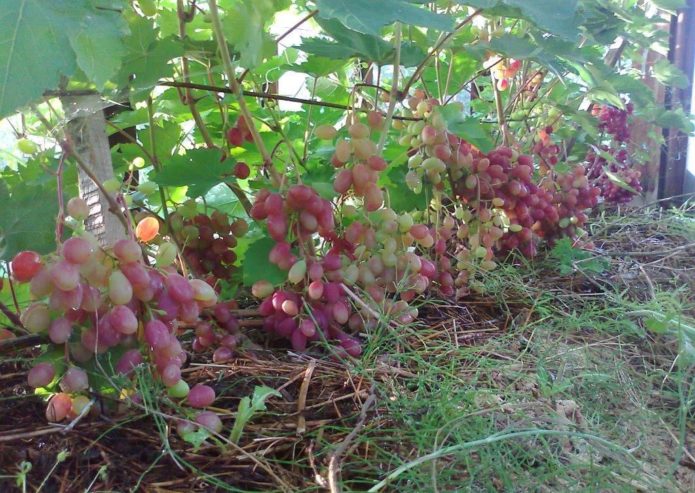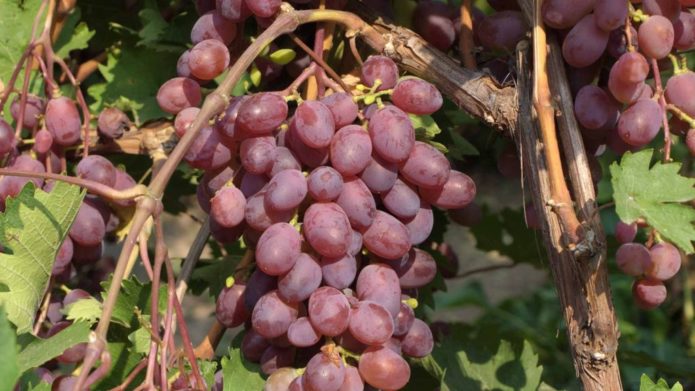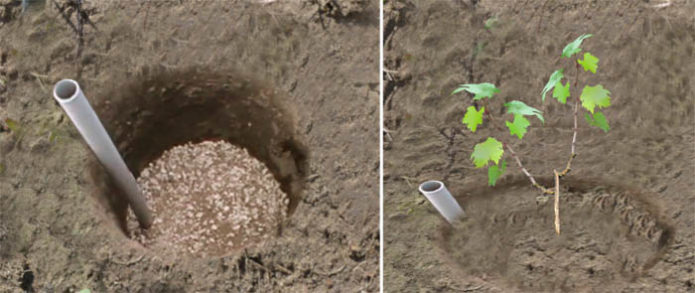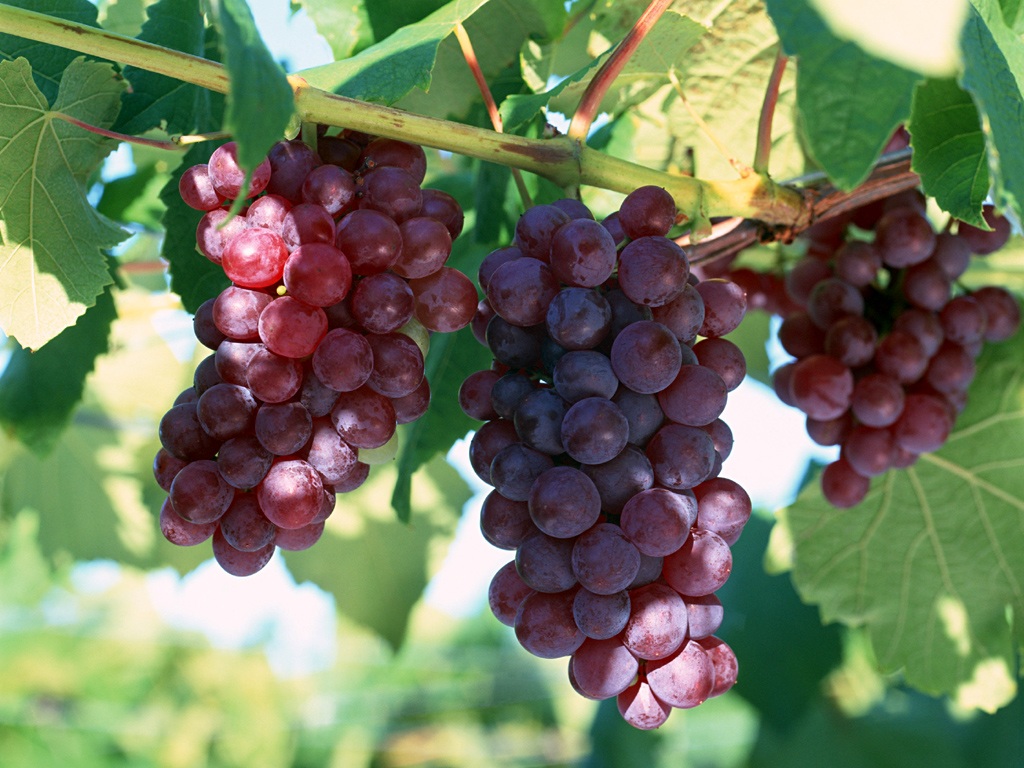The table grape variety Victoria is one of those that can be safely recommended for growing to beginners. This very frost-resistant variety is planted even in central Russia, in the Urals and Siberia. Victoria berries are delicious and beautiful, and large clusters serve as a decoration of the vineyard. Victoria's yields are stable even with not very careful care of the bushes and adverse weather conditions.
Content
History of breeding, description and characteristics of the Victoria grape variety
The Victoria grape variety has been known for a very long time and is a hybrid form derived from European and Amur grape varieties, from which it received high winter hardiness and productivity, unpretentious cultivation and resistance to many diseases. The variety was bred by domestic breeders in Novocherkassk. One of the “parents” of Victoria is the variety Save Vilar 12–304, which has high frost resistance. Another - a hybrid, descended from the varieties Vitis Amurenzis and Vitis Vinifera, that is, having both European and Amur "roots" in its pedigree.
In the process of breeding, a hybrid very similar to the Japanese varieties bred at Uehara station turned out, and one of the first versions of the name Victoria was exactly that, Uehara, which still introduces some confusion in the information about grape varieties.
In addition, it is quite natural that the popular word "Victoria" was not only used by Russian breeders for their products: grapes with the same or similar names exist in other countries. These are, for example, the Romanian Victoria, Victoria Gönge in Hungary, Victoria White in Ukraine and others. Therefore, when buying a bush or cutting, you need to thoroughly figure out what exactly is offered: these varieties differ very much in their characteristics.
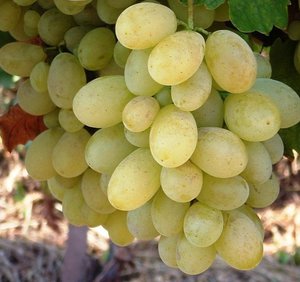
Ukrainian White Victoria is a completely different variety; when buying planting material, you need to understand well its origin
The Russian Victoria in question is exceptionally hardy: the bush hibernates normally without shelter at temperatures down to –27 ° C. In this regard, it is successfully grown not only in the southern regions of Russia, but also in the middle lane and even in Siberia. However, with a lack of heat, problems begin with pollination of flowers and ripening of berries. At the same time, in the middle latitudes, grapes need light shelter for the winter, and approximately starting from the Volgograd region, Victoria is not sheltered for the winter.
Victoria bushes are small: their growth strength is characterized as medium or even weak. The leaves are dark green, medium-sized, five-lobed, with slight pubescence. With proper care, the shoots ripen well, but due to the fact that up to 90% of them are fruitful, without rationing the yield, the bush seeks to preserve all the berries, as a result of which they become smaller, and the vine does not ripen. The yield of the variety is high even after removing part of the bunches. The variety is easily propagated by cuttings that root well. Victoria has an increased resistance to major fungal diseases.
Features of the technology of growing grapes in Siberia for beginners:https://flowers.bigbadmole.com/en/yagody/vinograd/vinograd-v-sibiri-dlya-nachinayushhih-posadka-i-uhod.html
The variety is considered early-growing: it begins to bear fruit in the second or third year. Victoria is an early ripening grape: it takes about 4 months from the beginning of the growing season to full ripening of the crop. In the Non-Black Earth Region, crops are harvested in late summer, in Siberia - in early autumn. The flowers are only female, therefore, in order to obtain a normal harvest, it is imperative to plant bushes of other varieties nearby, which will serve as pollinators. These varieties should bloom simultaneously with Victoria, the best options are Radiant Kishmish, Augustine, Crystal.
The bunches of the variety are large, beautiful, weighing up to 700 g. Their shape is usually conical, the packing of berries in bunches is from medium to dense. Berries of medium size, oval-ovoid, weighing from 5 to 8 g, very beautiful, bright in color. The main tone is red, with a raspberry tinge, the berries shine through in sunlight. The exact color depends on the weather conditions and even on the nature of the variety planted as a pollinator.
The berries are very juicy, they emit a slight crunch when consumed, the taste is harmonious, but rather sweet: the sugar content reaches 19%, and the total acidity does not exceed 6 g / l. When fully ripe, the berries acquire a light nutmeg aroma. The skin is very thin. Being a plus when eating berries, this fact badly affects the resistance of berries to sudden changes in humidity, they easily burst. Transportability and marketability are good.
Unfortunately, the variety is strongly affected by wasps, which limits its cultivation in large farms, where it is much more difficult to fight flying insects than if there is one bush in a summer cottage.
Growing grapes, tips for beginners and planting schemes:https://flowers.bigbadmole.com/en/yagody/vinograd/vyirashhivanie-vinograda-v-sredney-polose-dlya-nachinayushhih.html
Video: the influence of the pollinator on the shape of the Victoria berry
Features of planting and growing
From an agricultural standpoint, Victoria is a common early table grape. Its planting does not have any significant features in comparison with other grape varieties, and the peculiarities of caring for it are associated with the fact that it is a very frost-resistant variety, but requires careful pruning. Victoria reproduces well by cuttings, so you can grow her seedling yourself at home. If there is already a young bush of a different variety, Victoria can be grafted with a handle or an eye into this bush, you just need to carefully read about the compatibility of varieties, for grapes this is very important. Victoria, grafted onto a vigorous bush, produces larger berries.
Like all grape varieties, Victoria prefers to grow in sunny places, sheltered from the effects of cold winds. Therefore, when choosing a place for planting, this must be taken into account: it is good if there is a house wall nearby that protects the grapes from northern winds (or a fence). Victoria loves light soil, grows well on black soil, but tolerates any soil, except for very swampy. It does not require abundant watering, except for the period of berry growth. He also does not like waterlogging: the groundwater level should be higher than 2 m from the surface.
The best planting time in most regions is mid-April. In the south, grapes can be planted in the fall, but young plantings for the winter must be covered just in case. The planting technique is no different from other varieties.
Despite the small size of the bush, it is not necessary to strongly compact the plantings, and the distance to neighboring bushes should be at least two meters, or better - about three.
For spring planting in the fall, you need to dig up a plot with fertilizers, filling the soil with nutrients for the next few years. The planting hole for spring planting should also be dug in the fall.A pit for this grape is dug of the usual size, not less than 70 x 70 x 70 cm. A drainage layer must be placed on the bottom, especially in the case of clay soils: gravel, pebbles, broken brick. A layer of soil mixed with fertilizers (compost, wood ash, nitrophoska) is poured onto the drainage, and above it is a layer that will directly contact the young roots: fertile soil. The grapes are planted deeply, leaving 1–2 buds above the ground.
In arid regions, a vertical pipe should be placed in the planting hole so that for the first few years the grapes are watered directly into the root growth zone. When planting, it is necessary to spread the roots well, cover with soil, tamp and water. Mulching the soil around the seedling is always in place: it prevents the soil from drying out and prevents weeds from growing. You can plant low flowers nearby, especially early spring flowering (primroses, daffodils, tulips).
During cultivation, it is necessary to periodically water and feed the grapes. The applied fertilizers will last for 2-3 years. And then every year in early spring in the grooves dug along the periphery of the bush, you need to bring 1-2 buckets of humus, and at the beginning of summer a liter can of ash, slightly embedding it in the soil. Before the beginning of flowering and immediately after its end, foliar dressing with solutions of complex fertilizers is effective. During the growth of berries, top dressing should not contain nitrogen. Victoria does not like large amounts of fertilizers.
Grapes require annual formative pruning: the removal of dried shoots and excess branches thickening the bush. The fan-shaped bush is most convenient. In the spring, since Victoria's “crying” begins early, and it even looks like “sobbing”, pruning should be very light, and most of it is transferred to autumn.
If necessary, spring pruning of the cut site at Victoria should be well sprinkled with wood ash: this measure is not mandatory on most other varieties.
In addition, during the entire growing season, you should break out excess green shoots. The stepsons, in spite of the fact that berries are also tied on them, remove almost everything. This operation helps to ensure that by autumn only the necessary vines remain on the bush. Timely thinning of the bush also somewhat reduces the risk of berry cracking in wet weather, since it helps to ventilate the bush. In total, 25-30 eyes can be left on the Victoria bush, cutting off the shoots into 2-8 buds, depending on their power and location.
Unfortunately, it is imperative to pick off the extra bunches as soon as they appear: no more than two bunches should be left on each shoot. Peas are fought not only by breaking off excess branches: during the growth of bunches, small and dried berries are even removed by hand using various auxiliary tools like a hard paint brush.
There are recommendations from experts who claim that autumn pruning is preferable in regions with a harsh climate, and spring pruning in warm climatic zones:https://flowers.bigbadmole.com/en/uhod-za-rasteniyami/obrezka-vinograda-vesnoy.html
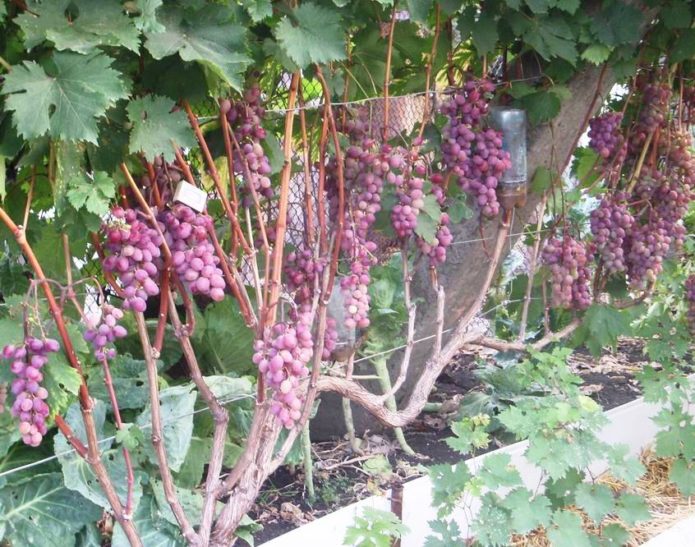
The bushes should be lightened as much as possible, and the bunches should be left as long as the bush can withstand
Victoria, possessing a high sugar content, is completely defenseless against wasps, which can destroy the entire crop. These striped pests have to be destroyed with baits: containers containing a sweet solution mixed with chlorophos. Naturally, it is necessary to destroy only the nascent hornets' nests.
The variety is quite resistant to diseases, but for their prevention, it is advisable to carry out several sprays per season with fungicide solutions. In the middle lane and in the north (Ural and Siberian regions) in October - early November, the bushes must be slightly covered for the winter. The variety is frost-resistant, it is enough, after removing the grapes from the trellises, cover it with spruce branches of coniferous trees.
Advantages and disadvantages of the variety in comparison with similar
It is customary to compare Victoria with varieties of the same ripening period. Usually, early varieties such as Victor or Arcadia are put somewhat higher: they have higher yields and fewer drawbacks. However, Victoria is almost a champion in frost resistance. And, although it is already a rather old variety, it does not give way to the young: after all, newer is not always better.
Victoria's undoubted advantages include:
- high yield: it has to be artificially reduced so as not to lose the bushes;
- simultaneous ripening of berries within the bunch;
- very good appearance of berries;
- early entry into fruiting (often already in the second year after planting or grape grafting);
- ease of care;
- the highest frost resistance;
- excellent ripening of shoots, subject to correct pruning;
- easy reproduction.
And if for many varieties the list of shortcomings takes only a couple of lines, for Victoria it, unfortunately, is very solid:
- caring for her is somewhat different from caring for many other varieties, mainly due to the need for serious rationing of the crop;
- Victoria is very strongly affected by wasps;
- with fluctuations in air humidity, the fruits are strongly cracked;
- a lot of "peas" are formed in the bunches;
- the presence of pollinating bushes is mandatory, and in unfavorable years it is desirable that there are at least two of them;
- low resistance of the crop to long-distance transportation;
- instability of berries to too high temperatures.
Of course, all these shortcomings can be combated, but this requires the application of effort and time, and experienced growers even consider Victoria to be a capricious variety, despite the fact that they recommend it for growing to novice gardeners. Indeed, it will bear fruit without leaving at all, but in order for the harvest to be very good, you need to work. For example, vineyards are known to stop watering a month before harvest. But Victoria reacts badly not only to high humidity, but also to any change in it, therefore, even in August, it is slightly watered at the root. Its cleanliness makes the owner literally comb the clusters with a broom or a brush to remove debris and dried parts.
All of the above leads to an ambiguous assessment of the Victoria grape variety. This is a wonderful grape, including for beginners, but in order for it to show all its positive qualities, it must be properly looked after.
Video: Victoria's harvest on the bushes
Reviews
This year, against the background of rainy sores, Victoria makes me happy. Still, this variety has positive advantages: high frost resistance and disease resistance. As for the wasps, the problem has been solved - the bunch bags have been waiting in the wings for a long time. In addition, despite the rains, the bush showed high yields and good pollination, without peas.
Victoria is a good variety, tasty, but I have not plucked a single brush on my site in 8 years. The top of the brush begins to sing and immediately the bottom of the wasps is still green as they ripen, they feast. Traps don't help. Arkadia is growing nearby and they do not touch her until they are finished with Victoria. I tried to hide it in bags, but it begins to wander and attract wasps even more. I had to uproot it, although it's a pity.
Victoria is a perfectly respectable form of grape. With the FZHTZ, the pollination of three seasons went well. It is very resistant to diseases, begins to ripen early. Fully ripe berry with excellent nutmeg flavor (a favorite of my women). The only serious drawback is that it is very loved by wasps. They begin to damage at the very beginning of ripening. It is imperative to hide the grons from the wasps - otherwise they will not have time to fully mature - they will gobble them up. In heavy rains, some berries crackled. The vine ripens perfectly. It is quite possible to keep a bush or two for yourself.
Victoria grapes are one of the recommended grapes for growing in small areas, including as the first variety for a summer resident taking the first steps in such an interesting business. However, having some drawbacks, it does not find application in industrial viticulture. With proper care, it produces excellent yields of delicious berries, but requires a lot of effort for this.
